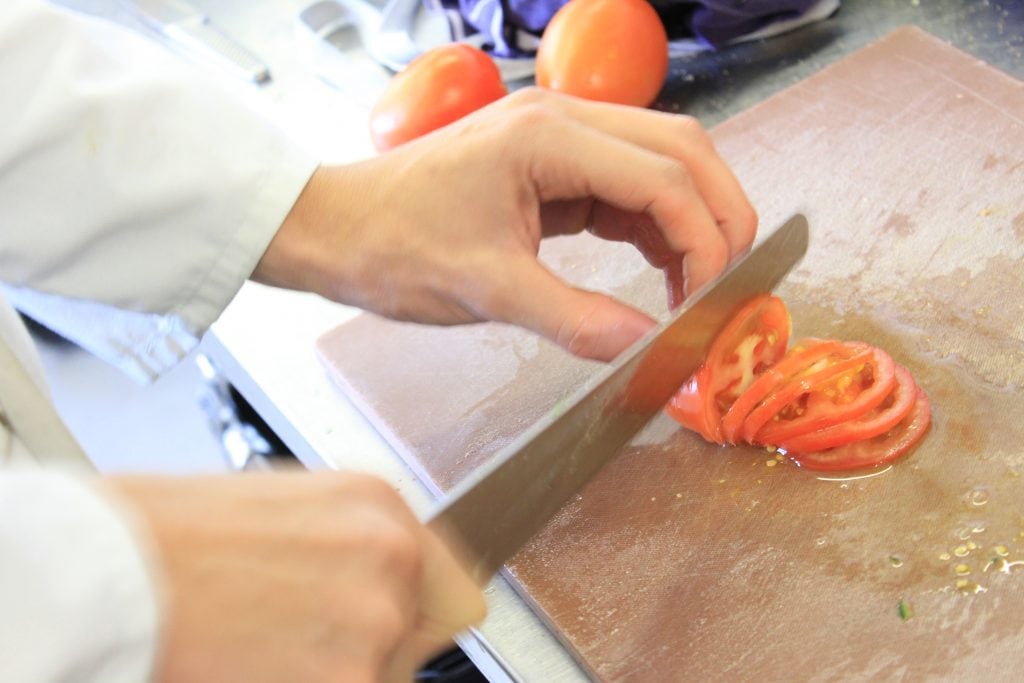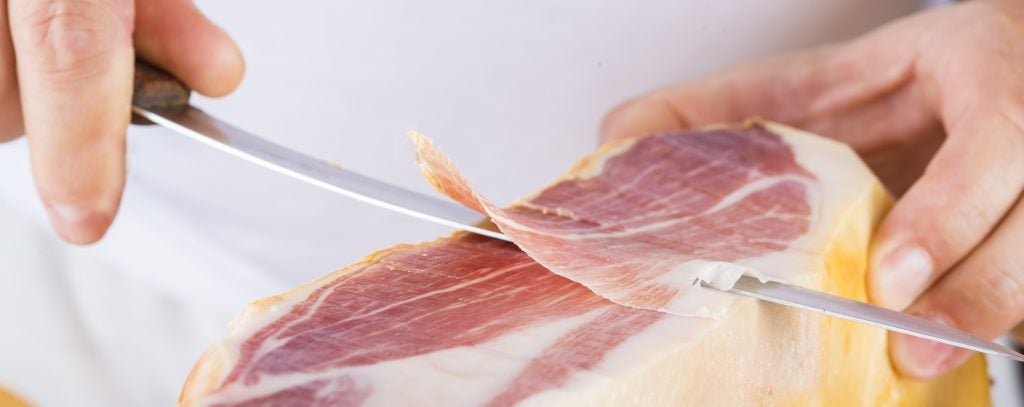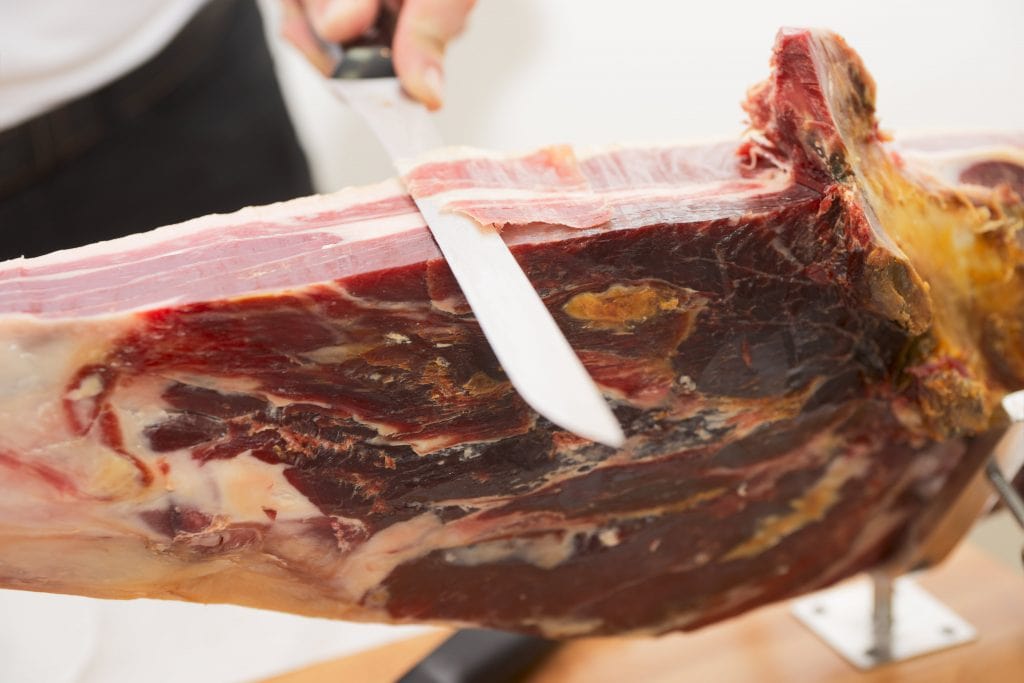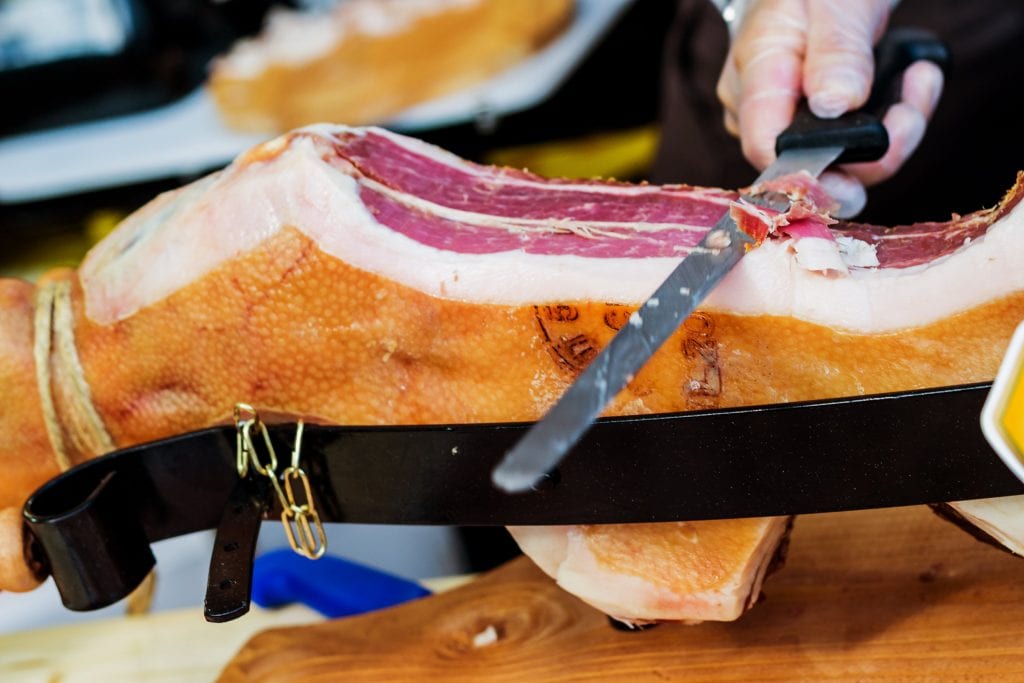You work hard in the kitchen to create delicious meals for your friends and family, so why not get a knife that serves up those perfectly cut morsels of food each and every time? You want a knife that gives you not only the presentation skills of expertly sliced meat, veggies, and fruits but also one that makes your job that much easier. Here is our list of the best attributes and qualities of slicing knives available on the market.
What is a slicing knife?
Slicing knives are similar to carving knives, except they offer more precision for the actual cuts. They usually have a thinner blade with either a round or pointed tip that allows you to get thinner slices of whatever food you are preparing. They work exceptionally well for softer food items like scallops or specialty meats with a bit of flexibility to handle the “give” of the food. Carving knives are meant to work around bones and have a far more rigid structure.
Slicing knives are good for:
- Cutting thin slices of meats and trimming fat
- Prepping veggies for salads and charcuterie
- Carving fruit with delicate detail

Slicing knives are not good for:
- Cutting through bones
- Smaller tasks like mincing
Do you really need a slicing knife?
Slicing knives provide you with an excellent tool for handling softer meats and getting that unwanted fat out of the way. Their precision cutting and sharpness allow for dealing with roasts, chicken pieces, veggies, and more. When you want a clean, quality cut for you and your guests, you need a tool in your kitchen that delivers every time. That is why owning a well-made slicing knife is money well spent.
How to hold and use a slicing knife?
While some chefs swear by the blade grip where you essentially “pinch” the blade as you cut, a slicing knife tends to be a bit thinner and should be used with a handle grip. This is done by holding onto the knife with your fingers tucked behind the bolster and your thumb placed on the blade for stability and agility. This is a safety issue primarily as a blade hold does give you more control. In the end, it will be your personal preference as you become more comfortable with the slicing knife in your kitchen.
No matter which hold you decide works for you, be sure your off-hand is safely in the “claw” position as you cut. Slicing knives are incredibly sharp, and you want to protect your fingers by holding the ingredient you are cutting in its place with the tips of your fingers angled away from the blade. You can rest the blade against your second knuckles as you cut. That physical connection gives you more guidance as to the location of the edge at all times and allows a fine slice.
How to Choose the Best Slicing Knife For You?
The best slicing knife is going to depend on our personal preference. However, you should always seek those unique blades designed for specific uses. While many professional chefs like having a solid “chef’s knife” on hand, they undoubtedly also have a set of other specialty knives for different tasks. You would never want to try dividing up a roast with a paring knife.
To help you with your final decision on the blade most likely to work for your style and kitchen, we’ve put together some different properties you should look at while shopping for a slicing knife.
Price – How Much Does a Slicing Knife Cost?
We all know price is a major factor for any item you want to purchase. You can find some good slicing knives for under $100 from big box stores and on Amazon, but if you want the real deal, you’re probably looking at $100 – $125 and up. The cost depends a lot on the materials being used for the metal and craftsmanship of the blade.
There are exquisite Japanese and German-made blades that can go up into the multiple hundreds depending on their forging. For most amateur chefs working in their own kitchens, you can find a decent knife for around $50-$75.
Dimensions – The Length & Weight of a Slicing Knife
Each slicing knife has two essential dimensions: length and weight. These matter because slicing knives are frequently used for meats like roasts, loins, and steaks that require longer blades to cut. You also want a knife with a bit more weight, so your wrist isn’t doing all the cutting work.
The length of a slicing knife
If you purchase a slicing knife that is too short, you will not get the cuts you want. A slicing knife is just that – slicing. That means you need to draw the blade across whatever you are cutting like a violin player. If it is too long, you’ll end up bumping into other things, which is never good.
The length range can be anywhere from 8-14 inches long (20.32-35.56cm). You’ll find most stores and online shops will carry slicing knives at 8 or 9 inches in length with maybe one or two of the longer 12-inch style.
What Is the best length for a slicing knife?
For most cooks, you would want a medium length that gives you the most versatility, which would be in the 10-12 inch range (25.4-30.48cm). These are long, narrow knives that allow a smooth draw for thin slices and a size that gives you the length needed for a single cut instead of going back and forth and causing harsh lines or frayed meat.

The weight of a slicing knife
The weight is measured from the total knife, including the blade, bolster, and handle. You need to be careful here because you want a knife that is well balanced. If you get too heavy a handle, the blade will always point up and not give a constant cut. The same is true if the edge is too heavy.
The weight can be higher than anticipated depending on the length of the blade and the quality of the material. Stainless steel is going to be lighter than true steel, for example. The range is often between 7 and 16 oz (198.4-453.6g).
What is a good weight for a slicing knife?
This is harder to peg down because it depends on the material being used for creating the slicing knife. In our research, the best weights tend to be right around 7-9oz because that doesn’t feel too heavy in hand and allows a balanced cut with the blade between 10-12 inches.
The Slicing Knife’s Blade
A slicing knife has a single-handed handle with a low bolster and long blade. It tends to have more flexibility than other knives and offers an extreme sharpness for precision cuts and thin slicing. This is an excellent blade for cutting meat like loins, breasts, and steak. The shape is long and narrow with either a rounded or pointed tip and various edge types.
Blade Material – What material should a slicing knife blade be made of?
The materials being used to make slicing knives matter a great deal for the blade’s price, capability, and weight. You’ll find everything from stainless steel to true steel to high carbon steel and many variations in between. High carbon steel is the best because this ensures longer-lasting edge sharpness. If you can get a combination with stainless steel attributes in the handle, you’ll have lower maintenance.
Blade Length – How long should the blade of a slicing knife be?
Again, the best length we’ve found was in the 10-12 inches range. This is measured from the bolster to the tip. You will find quite a lot of lower-priced slicing knives in the 8-9 inch range, which is appropriate for small families of 2-3 people who do not use large cuts of meat. Once you start cooking for 4-7+ people, you should invest in a longer blade for your convenience.
Blade Height/Width – How high/wide should the blade of a slicing knife be?
This is surprisingly one of the most varied measurements in designing a quality slicing knife. You will find many heights for a slicing knife because of the manufacturer and materials being used. Slicing knives tend to be on the narrower end of the spectrum because you’re getting a smooth, long slice through an ingredient. You should look for 0.5-1.2 inches, with 0.7 inches or so being the sweet spot.
Blade Flexibility – Should a slicing knife have a flexible blade?
You absolutely want a flexible blade with a slicing knife. That is one of the qualities that makes them so unique and helpful. The higher the degree of flexibility, the more your slicing knife will be able to successfully maneuver through every cut.

Blade Width/Thickness – How thick should a slicing knife blade be?
This goes hand in hand with flexibility. The thicker the blade, the harder it is to get between those intricate ingredients when you’re seeking a thin slice. The rule of thumb is to find a thinner slicing knife because it allows you more versatility in your cutting. You may come across blades with pockets to allow space while they cut. This changes the thickness and isn’t the best idea for a smooth cut. Stick to the idea that the narrower the blade, the better the cut, and you should be fine.
Tang for a slicing knife
Ideally, you’re going to want a slicing knife with a full tang. This means the blade’s metal goes from the tip of the knife all the way through to the end of the handle. This makes for a much safer knife with a lot more control, enhancing the longevity of your purchase. On the other hand, partial tang construction separates the blade from the handle and may change the way the bolster is forged. While some slicing knives are good with partial tangs, we highly suggest sticking to full tang construction.
HRC for a slicing knife
HRC stands for the Rockwell Hardness Scale and measures the hardness of the actual blade. Essentially you are getting a “toughness” rating for durability and flexibility. You’ll find a range between 55-66 in HRC depending on the material being used and the manufacturer for slicing blades. The higher the HRC, the tougher the steel, which can impact price and balance. We’ve found many blades to be desirable around the 56-58 HRC range.
Should a slicing knife be Forged or Stamped?
This is the difference in knife creation. A forged blade is a single piece made from a mold where metal is poured in. A stamped bladed is more mass-produced and cut out of a metal piece. Both have their advantages.
A stamped blade tends to be more lightweight and flexible but will not offer the same durability or longevity as a forged blade. However, forged blades are often thicker and heavy, making them less flexible. This choice will depend on your personal preference, but we always lean a bit more towards flexibility with a slicing knife.

The Slicing Knife Handle
The handle you select should be sturdy and comfortable first. This is a blade that requires precision work, and you want a handle that allows full maneuverability and fits well in your hand. This can be a challenge if you are shopping online and cannot physically pick up the handle.
The typical full tang handle consists of the bolster, which is a raised piece of metal separating the blade from the handle for safety, the rivets holding the two parts of the handle (scales) in place around the metal of the tang, and the butt, which is the end of the handle.
When you are shopping for a slicing knife, watch for a handle with:
- Size – should at least fit a single hand with at least a thumb’s width of handle poking out of your fist at the end.
- Comfort – something that allows a grip that won’t slip and can be turned and maneuvered with ease.
- Material – stainless steel or plastic are best as they don’t allow containments to grow like a wood handle.
- Shape and design – we like a curve underneath with a thick butt so the blade won’t easily slip out of your hand.

Balance – What’s the right balance for a Slicing knife?
The balance of a slicing knife is the most important measurement. It shows the attention to detail and knowledge of construction a quality manufacturer should present. With a well-balanced knife, you’ll be able to cut for hours without any discomfort in your wrist and end up with much more precise cuts.
A good slicing knife is going to be lightweight with an even balance. The easiest way to test for this is to extend your index finger, hold up the knife with a bolster resting on your finger, and balance the knife as a see-saw. If it leans towards the handle, it is handle-heavy and vice versa. The more even the slicing knife rests on your finger, the better.
Maintenance and Care – How to maintain a Slicing Knife?
Having quality materials for your slicing knife will significantly impact the overall maintenance required. The better the metal, like high carbon steel or stainless steel, the less you must sharpen and treat your blades. For the most part, hand washing and occasional sharpening will be routine
How to clean a slicing knife?
The moment you are done with whatever you are slicing, clean your blade by hand washing your knife, drying it, and putting it away. Do not leave your knife out or in a sink with soap because you never know when an unwanted hand may suddenly reach into the sink and get sliced.
Use clean, warm water with mild dish soap to remove any food debris or bacteria from the knife. Do not let your knives sit in water and then air dry, which could encourage rust or damage to the blade. Always dry it off and then replace it in its proper location.
Be sure to pay close attention to any nooks and crannies in the blade construction. This is a common blade for cutting meat, and you do not want any debris leftover that can lead to food safety issues later on.
Are slicing knives dishwashers safe?
Even if the package says your knife is safe for the dishwasher, we highly recommend not using it. The jets from a dishwasher blast the sides of a knife with scalding hot water, and we tend to leave our dishes in the washer to air dry instead of immediately using a towel. All of this can lead to damage along the blade, and you don’t want to harm its longevity or sharpness.
Learn how to remove rust from a knife blade and how to protect your kitchen knife from rusting.
Honing & sharpening your slicing knife – how to keep your slicing knife sharp?
There are a few ways to keep your sharpening knife cutting at full sharpness. This includes a whetstone, honing steel, and electric sharpener. Honing is our preferred method because it keeps the blade sharp by pushing the knife’s edge back to the center. Sharpening removes material from the blade to produce a sharper edge. We suggest using an electric or honing steel about every 1-2 months, depending on your use.
Read now >> How to tell if a knife is sharp?
How to store a slicing Knife?
Safely storing your slicing knife is essential to kitchen safety. These are incredibly sharp blades that tend to be lightweight and narrow, which means they can cause some damage in little hands or accidents. We suggest using a knife magnet out of reach of children or drawers with specific spaces for your specialty blades.
Always put your knife away when it is completely dry. Leaving any moisture can lead to contaminants and dullness. Clean and dry off the blade, then place it into a block, drawer, or on a knife’s magnet.
Conclusion
There is a lot of detailed information in this guide for purchasing a new slicing knife. To make it easy for you, stick to a blade about 10-12 inches in length with full tang and a metal or plastic handle that you can grip well. If you can find a high carbon steel construction, even more, the better.
The goal is to find a high-quality slicing knife that is lightweight and flexible enough to allow you complete maneuverability while you get those delicious thin slices of meats, veggies, and fruits you want the most. Take your time and pay close attention to balance and materials, and you should be fine. While you’re at it, be sure to pick up decent honing steel as well to keep your slicing knife nice and sharp. Happy shopping and we hope we have provided you with all the info needed to get a great knife for your next kitchen creation!
